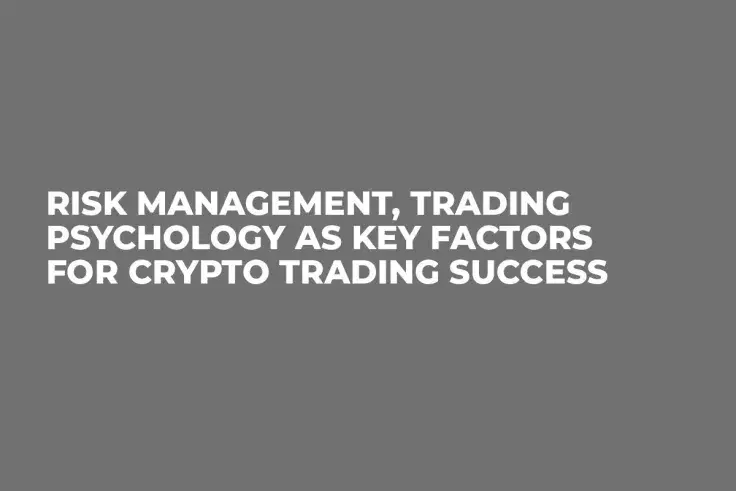
When you hear somewhere that your trading success depends on a good strategy or luck, it is not true. The key factors of long-term profit in cryptocurrency trading are money and risk management as well as trading psychology.
Most newcomers try to avoid those subjects first thinking that will learn some strategies and use them carefully in order to reach their goals. However, they start to lose money and the more they waste, the closer is the moment they open such articles as this one looking for answers to their numerous questions.
We have gathered here the most important key aspect that help professional traders to succeed. First, we are going to cover money and risk management and give you several recommendations on how to use them in practice.
Money and risk management
The importance of those aspect is hard to overestimate as they play an important role in trading in general. There is no a single professional trader who skip money and risk management in his or her daily trading routine. Let’s see some useful advice:
Do not overheat your trading account
This is one of the main rules of money and risk management. There are several ways to overheat your trading account including overtrading, breaking money management rules and the others. What does it mean “to overtrade”?
Most beginner traders and investors think that the more orders they place, the more money they will earn. This sounds obvious, but in practice, the more you trade, the more risks you take as you have less money in reserve.
What is an average number of trades per day? There is no answer to this question as everything is individual and depends on many factors including the number of trading opportunities, initial funds, trader’s mental and physical state and the others.
Many beginners think that they always have to “stay in market” in order to take advantage of every crack. However, this is the best way to overheat your account by overtrading. There is no need to place a trade just in order to be in market all the time.
The best crypto strategy for every trader is to find entry points before placing orders and use them in order to gain profit and not vice versa.
Determine your risk levels
When you trade cryptocurrencies, you need to determine your risk levels for every single order meaning you will close your positions manually or automatically once this point is reached. How does this work in practice?
Let’s say, you have $10,000 on your trading account and determine risk at five percent level. You buy a certain number of cryptocurrency for $1,000 but your forecast was wrong and the price went downwards. Your risk level is $50 meaning you can not lose more than this amount in a single trade.
Why is it necessary to determine risks per every position? This is useful not only for your money and risk management strategy but also for your mental state as you are prepared to lose this amount already. However, when you fail to close your position at this level, your losses will grow leading to all your negative emotions to take control over you.
Use stops, limit orders carefully
Most novice traders when they first start their cryptocurrency trading try to use all types of orders thinking that they can improve their results by placing market or limit positions. This approach is right and helpful but only when they understand what they are doing and what targets do they have.
Limit orders are useful only when you have conducted your analysis and found out that the price of the asset will reach a certain level before going into the forecasted direction. Otherwise it makes no sense to wait. Sometimes it is better to use simple market orders when you suppose that the price will start to grow from current level or somewhere close to it.
As for stops, they are also helpful as they are part of risk management strategy. However, before placing such an order, you need to calculate your potential risks carefully. You can also use trailing stops in order to automate your risk management strategy.
Calculate your risk/reward ratio
This is an important rule for both traders and investors. Risk/reward ratio should be at least 1:2. If less, you won’t be able to increase your funds in the long term using simple trading strategies with 50/50 profit/loss ratio.
What does it mean to calculate risk and reward? Let’s see an example. A trader wants to buy one Bitcoin for $7,000. He is ready to lose $300 in this position (which is equal to 1 risk unit). When using such risk amount, he is to plan $600 profit in order to follow his 1:2 risk/reward ratio strategy.
Those are the main recommendation related to risk and money management. Now it is time to get down to trading psychology.
Trader’s emotions that can ruin any trading system
Professional traders know that emotions in investing are the worst enemies capable of ruining their funds quickly. This is why they always need to control them and to be self-disciplined in order to become successful.
Kill your greed before it kills your money
Trading seems to be like gambling for novice traders. They think that their routine consists of placing orders and winning money. However, there is a big difference between trader and gambler as first is guided by his trading system and the second by greed.
What is greed and why should investors control it? This is a small animal, sleeping inside of most of us. However, once we sit down to play cards, roulette or trading, this animal awakes asking for food. It tells you to increase your per trade amount, forget about your system, do not close your positions at stop loss levels etc.
Greed is a good quality for casino holders only as they make money on gamblers. The more player bids, the more he will potentially lose. However, for traders greed is something that may kill all their efforts.
Let’s say you have earned $10,000 by trading for nearly half a year. It was not the easiest period as you had to be self-disciplined, to follow your strategy, to manage risks and money. This is your first positive result.
Greed isn’t sleeping now and it makes you make mistakes by increasing your per trade volume, holding trades to take more profits and many other things that are contrary to your trading system.
Control your fears
Another bad emotion that may affect your results negatively is fear. It shows up after one or several losing positions. In contrast to greed, fear is unable to ruin your fortune, but it prevents you from making money when trading.
Why should you control all your trading fears? First, they make it difficult for you to take reasonable decisions. Affected by fears, traders sometimes miss evident opportunities to open position. In other cases, fears paralyze investors meaning speculators are afraid to make any decision at all.
However, this is not the end of the list. Fears affect your trading even when the position is in play already. Influenced by this emotion, traders try to close their positions as quickly as possible, gaining less than they could make by holding trades for a longer period.
How to control emotions in trading
There are several ways to do it as well as several tools to use in order to smooth the influence of emotion to trading. The first thing that is to be mentioned is self-discipline. Most beginners will say that they are enough disciplined in their everyday life. However, those words are far from being true.
Self-disciplined traders follow their trading plan, trading system, 24/7, 365 days per year for their lifetime. Otherwise, they lose. Is it easy to be self-disciplined all the time? Naturally, it is not! Even professionals may step out their way and break their own rules. However, they do understand why they commit such a mistake and try to follow their strategies in future.
What are the main tools that help traders to control their mindset? They are the following:
-
Trading plan. Here you can describe all your trading tools including indicators that you use or even your strategy. Trading plans may also include your notes on this or that trading situation.
-
Money management system. You need to calculate it in advance in order to not wasting your time for this when trading.
-
Risk management. Once described in your trading plan, this aspect should be applied for your every trade.
Stay patient when trading
Patience is one of the key factors for traders to succeed. You need to be patient not only when waiting for an opportunity to open positions, but also after your trade is already in the game. Why is this aspect necessary?
Let’s suppose you monitor BTC/USD looking for better price position in order to place an order. Most beginner traders hurry up to enter the market and do this even if there is no clear opportunity. Professionals are patient as they wait for the price to meet their trading strategy conditions before placing an order. What are those conditions? They may be the following:
-
The price reached the resistance (or support) are and reversed. This is a signal that the price is able to move in the opposite direction in the nearest future. Beginner traders sometimes place orders when the price is close to those levels without knowing whether quotes will break out the area or reverse.
-
Candlestick pattern (hammer, e.g.) appeared. Professional traders always wait until this bar closes as they need to know for sure that there is a hammer there. Newcomers sometimes open trades even if the bar is in progress. This is a big mistake as the situation may change by the end of the period of candlestick formation.
-
RSI curve jumped into oversold or overbought area. This is not a signal as many beginners think. This is just an alert to prepare for trading. The signal appears when the curve leaves oversold or overbought areas.
Those are not all the conditions, but just a couple of them. Newcomers make mistakes after they have opened positions as well. The biggest one is that they are impatient to hold their trades in order to let them bring more profit.
Some recommendations
Trading psychology is one of the most important section of your training. Once you understand yourself and learn how to control your emotions, you may have better results. We are going to give a couple of recommendations.
Trading is a long voyage
The majority of newcomers dream about millions and even billions of dollars the next day. They think that one year of investing may change their life forever. However, this is not true. Trading is a long voyage, which lasts for a lifetime.
Instead of dreaming about cars, girls, cocktails on the seashore, villas trader is better to set targets to himself or herself to reach in one month, six months, one year etc.
Stay fit
What is the connection between fitness and trading? An investor who places his orders a couple of times per day needs to be fit. Mentally exhausted or tired traders have fewer chances to make money in this industry.
Try to work when you are “fresh” meaning you need a clear head in order to make better market decisions. Exhausted traders have less chances to succeed as they make more mistakes during all trading stages including analysis, entry point finding, stop loss calculations etc.

 Dan Burgin
Dan Burgin Vladislav Sopov
Vladislav Sopov U.Today Editorial Team
U.Today Editorial Team